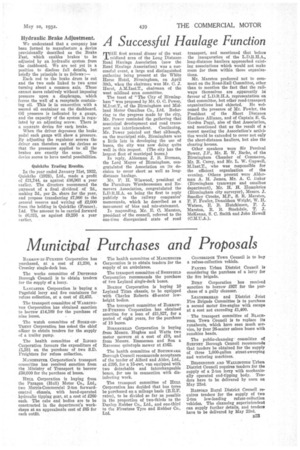The Road Traffic Act and Public Safety
Page 36

Page 37

If you've noticed an error in this article please click here to report it so we can fix it.
THE National Safety Congress in London opened last Wednesday with a civic welcome to the delegates by the Mayor of the City of Westminster, the Rev. E. St. G. Schomberg, MA., at the Caxton Hall, Westminster, S.W.1. This ceremony was followed by the reading by Sir Henry Piggott, C.D., C.B.E., Deputy Secretary to the Ministry of Transport, of a paper which Mr. P. J. Pyhus, C.B.E., M.P., the Minister of Transport (who was in the chair), described as a very stimulating address. It was entitled "The Road Traffic Act, 1930, and its Bearing on Public Safety."
At the outset Sir Henry Piggott said that when the years 1930 and 1931 were compared, statistics showed a definite reduction in the number of accidents, but for the first quarter of 1932 the figures were most disquieting. This matter, he thought, was one of gravest concern.
Little more, he thought, could be done to improve matters by legislation. It was no good increasing the penalties. Reckless drivers were, in his opinion, a menace and a nuisance and it was necessary that public opinion should be aroused. It was largely to this that he attributed the decrease of accidents during 1931.
Referring to accidents caused by vehicles themselves being in an unsafe condition, he mentioned the fact that public service vehicles were subject to an inspection, and quoted these figures: where 13,500 certificates of fitness had been issued, only 559 had been refused. Reports, he continued, showed that, although few in number, many of those vehicles refused certificates were in a very unsatisfactory condition.
There were, he said, for commercial vehicles definite limits to the periods for which one man might drive continually. It was hard to tell how many accidents were due to the weariness of a driver—no one could tell—but fatigue certainly lessened concentration. The matter was hard and practically impossible to investigate, and it would be difficult to enforce a similar limit among private drivers. In conclusion, he remarked that motor driving must no longer be regarded as a field for adventure.
A discussion, opened by Mr. F. G. Bristow, the general secretary of the Commercial Motor Users Association, followed the reading of the paper.
In replying to questions raised in the discussion, Sir Henry said that it would be a gigantic task to inspect the mechanical condition of all commercial vehicles, but he thought that there was a possibility that they might be brought under some such form of control.
Hydraulic Brake Adjustment.
We understand that a company has been formed to manufacture a device provisionally described as the Brake Fast, which enables brakes to be adjusted by an hydraulic system from the dashboard. We are not yet in a position to disclose full details, but briefly the principle is as follows :— Each rod to the brake drum is cut and the two ends linked to two arms turning about a common axis. These cannot move relatively without imposing pressure upon a diaphragm, which forms the wall of a receptacle containing oil. This is in connection with a second oil container on the dashboard. Oil pressure is indicated by a gauge, and the capacity of the system is regulated by an adjusting screw. There is a separate device for each brake.
When the driver depresses the brake pedal each gauge will show a pressure. By adjusting the regulator screws the driver can therefore set the devices so that the pressures applied to all the brakes are exactly the same. The device seems to have useful possibilities.
Quicktho Trading Results.
In the year ended January 31st, 1932, Quicktho (1928), Ltd., made a profit of £21,744, as against £36,963 a year earlier. The directors recommend the payment of a final dividend of 2d., making 3d., per 2s. share for the year, and propose transferring £7,000 to the general reserve and writing off £2,000 from the holding in Quicktho (France), Ltd. The amount to be carried forward is £6,375, as against £9,256 a year earlier.




























































































